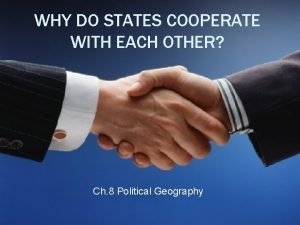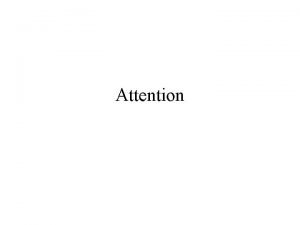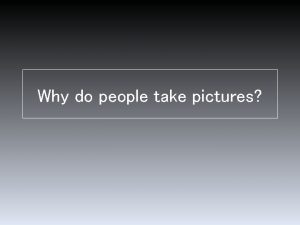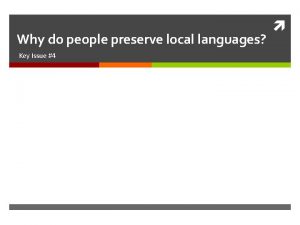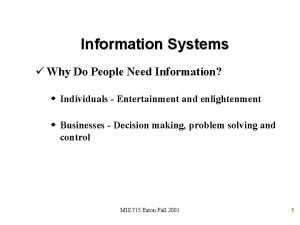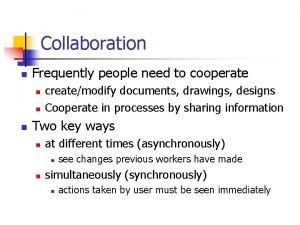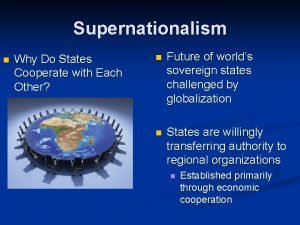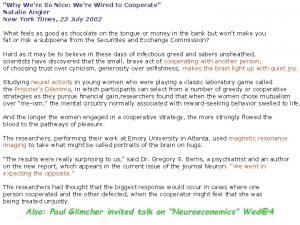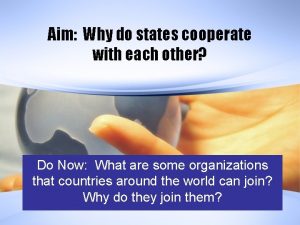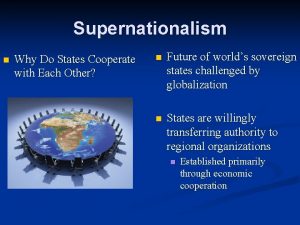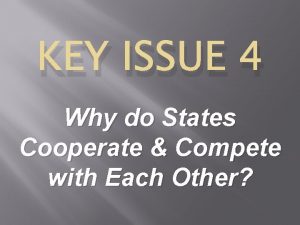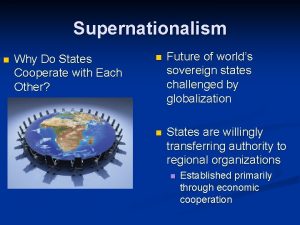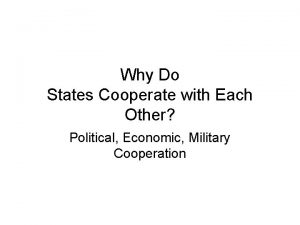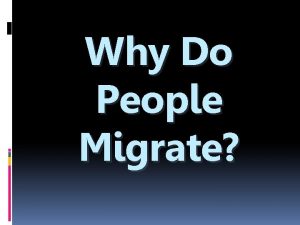Cooperate Without Looking Why we care what people











































- Slides: 43

Cooperate Without Looking Why we care what people think and not just what they do Moshe Hoffman, Erez Yoeli, and Martin Nowak Program for Evolutionary Dynamics, Harvard University

Motivation…

“Will you do me this favor? ” “What’s in it for me? ” “Let me think about it… OK. ” “Who else is coming? ” VS. “Of course, no problem!” “Action from duty has its moral worth not in the purpose to be attained by it but in the maxim in accordance with which it is decided upon”

VS. “Act in such a way that you treat humanity… never merely as a means to an end, but always at the same time as an end. ”

VS.

Cannot be explained by… C D b-c -c b 0 δ C D C b-c -c D b 0 δ C D b-c -c b 0 δ …

Our model…

“The Envelope Game” High Temptation Low Temptation C a, b D c H, d c L, d c. H > c. L > a> 0 bp + d(1–p) < 0 < b

1. Model variation in costs of cooperation

2 2. Model player 1’s choice of whether to “look” Crucial assumption: others (player 2) can observe whether player 1 looked

2 3. Player 1 then chooses whether to cooperate or defect 2 is again able to observe High Temptation Low Temptation C a, b D c H, d c L, d c. H > c. L > a> 0 bp + d(1–p) < 0 < b

4. Model others’ “trust” in Player 1

Results…

The strategy pair (CWOL) Player 1: Don’t look and cooperate Player 2: Exit if player 1 looks or defects is a stationary, subgame perfect equilibrium iff: a/(1 -w) > pc. L + (1 -p)c. H

The strategy pair (CWL) Player 1: Look and cooperate Player 2: Exit if player 1 defects is a stationary, subgame perfect equilibrium iff: a/(1 -w) > c. H

The strategy pair (ONLYL) Player 1: Look and cooperate iff temptation is low Player 2: Exit if player 1 defects when temptation is high is a stationary, subgame perfect equilibrium iff: pb + (1 -p)d < 0

The strategy pair (ALLD) Player 1: Defect Player 2: Exit is always a stationary, subgame perfect equilibrium

CWOL, CWL, ONLYL, and ALLD are the only stationary, subgame perfect equilibria of the envelope game Then…

The strategy pair (CWOL) Player 1: Don’t look and cooperate Player 2: Exit if player 1 looks or defects is the only cooperative equilibrium provided: c. H > a/(1 -w) > pc. L + (1 -p)c. H pb + (1 -p)d < 0

The strategy pair (CWOL) Player 1: Don’t look and cooperate Player 2: Exit if player 1 looks or defects is the only cooperative equilibrium provided: large rare temptations defection is harmful

Dynamics…

Why? Is game theory relevant? Multiple equilibria. Does CWOL emerge?

How?

1. Limit to small number of strategies

2. Strategies “evolve” according to replicator

3. Start at random point in parameter region and solve replicator

4. Classify end points

Results…


CWOL ONLYL ALLD

Applications…

“Will you do me this favor? ” “What’s in it for me? ” “Let me think about it… OK. ” “Who else is coming? ” VS. “Of course, no problem!” “Action from duty has its moral worth not in the purpose to be attained by it but in the maxim in accordance with which it is decided upon”

VS. “Act in such a way that you treat humanity… never merely as a means to an end, but always at the same time as an end. ”

VS.

Stewart on flip flopping (at 4: 15)

More…


VS. Just ask Larry David





Part of broader approach: apply game theory to preferences and ideologies Questions or comments? eyoeli@fas. harvard. edu
 How do states cooperate with each other
How do states cooperate with each other Looking out looking in summary
Looking out looking in summary Looking out looking in chapter 9
Looking out looking in chapter 9 Hey bye bye
Hey bye bye Looking without seeing
Looking without seeing Levels of care primary secondary tertiary quaternary
Levels of care primary secondary tertiary quaternary Why did people care about the butler act
Why did people care about the butler act Don't ask why why why
Don't ask why why why Without title diane glancy
Without title diane glancy Without title by diane glancy
Without title by diane glancy Why does pablo neruda urge to keep quiet
Why does pablo neruda urge to keep quiet People without jobs
People without jobs Why do humans cannot survive without minerals
Why do humans cannot survive without minerals When you say things without thinking
When you say things without thinking People as media and people in media difference
People as media and people in media difference People killin people dyin lyrics
People killin people dyin lyrics Recovery community
Recovery community People just people
People just people We care about people
We care about people People dont care
People dont care Duty of care outcome care certificate
Duty of care outcome care certificate Magnetul este un corp care atrage
Magnetul este un corp care atrage Palliative care versus hospice care
Palliative care versus hospice care Animale care fac oua
Animale care fac oua Care sunt simturile prin care sunt evocate
Care sunt simturile prin care sunt evocate Care certificate standard 10
Care certificate standard 10 Hip fracture care clinical care standard
Hip fracture care clinical care standard Health and social care values unit 2
Health and social care values unit 2 Why did orwell use animals instead of people
Why did orwell use animals instead of people Why do people travel
Why do people travel I hate careless people thats why i like you
I hate careless people thats why i like you I hate careless people thats why i like you
I hate careless people thats why i like you Why do the bodys antibodies fail to protect people from hiv
Why do the bodys antibodies fail to protect people from hiv Immigration v emigration
Immigration v emigration Why do people create, structure, and change governments?
Why do people create, structure, and change governments? Why people die by suicide joiner
Why people die by suicide joiner Why do people take pictures
Why do people take pictures Why do people preserve local languages
Why do people preserve local languages Why do people need information
Why do people need information Why do people celebrate easter
Why do people celebrate easter Join the roman army
Join the roman army B7zwwo9dbiu -site:youtube.com
B7zwwo9dbiu -site:youtube.com Period of activism 1970 to 1972
Period of activism 1970 to 1972 Why mosquitoes buzz in people's ears summary
Why mosquitoes buzz in people's ears summary
